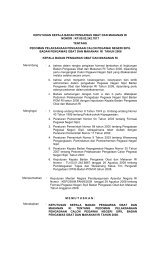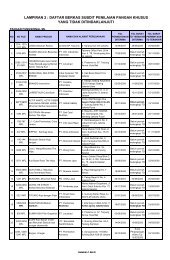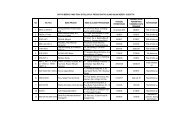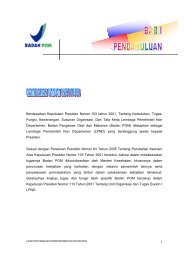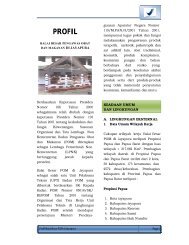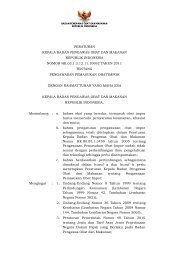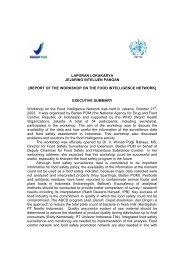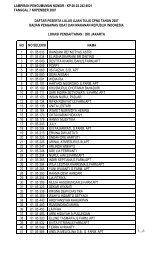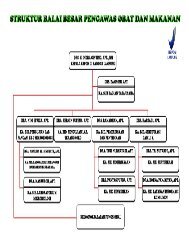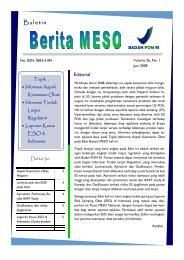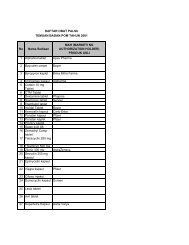Badan Pengawas Obat dan Makanan Republik Indonesia ...
Badan Pengawas Obat dan Makanan Republik Indonesia ...
Badan Pengawas Obat dan Makanan Republik Indonesia ...
- No tags were found...
Create successful ePaper yourself
Turn your PDF publications into a flip-book with our unique Google optimized e-Paper software.
Aneks 1 – Pembuatan Produk Sterilkarakteristik lingkungan yangdipersyaratkan. Tiap kegiatanpembuatan membutuhkan tingkatkebersihan ruangan yang sesuai dalamkeadaan operasional untukmeminimalkan risiko pencemaran olehpartikulat <strong>dan</strong>/atau mikroba pada produk<strong>dan</strong>/atau bahan yang ditangani.4. Kondisi “operasional” <strong>dan</strong>“nonoperasional hendaklah ditetapkanuntuk tiap ruang bersih. Keadaan“nonoperasional” adalah kondisi di manafasilitas telah terpasang <strong>dan</strong> beroperasi,lengkap dengan peralatan produksitetapi tidak ada personalia. Kondisi“operasional” adalah kondisi di manafasilitas dalam keadaan jalan sesuaimodus pengoperasian yang ditetapkandengan sejumlah tertentu personaliayang se<strong>dan</strong>g bekerja.Agar tercapai kondisi “operasional”maka area tersebut hendaklahdidesain untuk mencapai tingkatkebersihan udara tertentu pada kondisi“nonoperasional”.Pada pembuatan produk sterildibedakan 4 Kelas kebersihan:Kelas A: Zona untuk kegiatan yangberisiko tinggi, misal zona pengisian,wadah tutup karet, ampul <strong>dan</strong> vialterbuka, penyambungan secara aseptis.Umumnya kondisi ini dicapai denganmemasang unit aliran udara laminar(laminar air flow) di tempat kerja. Sistemudara laminar hendaklah mengalirkanudara dengan kecepatan merataberkisar 0,36 – 0,54 m/detik (nilaiacuan) pada posisi kerja dalam ruangbersih terbuka.Keadaan laminar yang selalu terjagahendaklah dibuktikan <strong>dan</strong> divalidasi.Aliran udara searah berkecepatan lebihrendah dapat digunakan pada isolatortertutup <strong>dan</strong> kotak bersarung tangan.Kelas B: Untuk pembuatan <strong>dan</strong>pengisian secara aseptis, Kelas iniadalah lingkungan latar belakang untukzona Kelas A.Kelas C <strong>dan</strong> D: Area bersih untukAnnex 1 – Manufacture of SterilePharmaceutical Productsto the required characteristics of theenvironment. Each manufacturingoperation requires an appropriateenvironmental cleanliness level in theoperational state in order to minimizethe risks of particulate and/or microbialcontamination of the product and/ormaterials being handled.4. The “in operation” and “at rest” statesshould be defined for each clean room.The “at rest” state is the condition wherethe installation is installed and operating,complete with production equipment butwith no operating personnel present.The “in operation” state is the conditionwhere the installation is functioning inthe defined operating mode with thespecified number of personnel working.In order to meet “in operation” conditionsthese areas should be designed toreach certain specified air-cleanlinesslevels in the “at rest” occupancy state.For the manufacture of sterilepharmaceutical products 4 Grades canbe distinguished:Grade A: The local zone for high riskoperations, e.g. filling zone, stopperbowls, open ampoules and vials, makingaseptic connections. Normallyconditions are provided by a laminar airflow work station. Laminar air systemsshould provide a homogeneous airspeed in a range of 0.36 – 0.54 m/s(gui<strong>dan</strong>ce value) at the working positionin open clean room applications.The maintenance of laminarity should bedemonstrated and validated. A unidirectionalair flow and lower velocitiesmay be used in closed isolators andglove boxes.Grade B: For aseptic preparation andfilling, this is the backgroundenvironment for Grade A zone.Grade C and D: Clean areas for carryingEdisi 2009 - 14 - 2009 Edition



